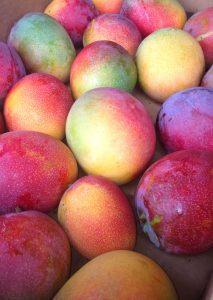How can I tell if Hayden mango tree will bear fruit. I planted a 3’ Haden mango tree 5‐6 years ago.
Mango trees have soil, irrigation, and fertilizing needs that encourage flowering and fruit production.
Pruning your tree will also help with yield. Mangos typically fruit in summer, with flowers forecasting production in early spring. It typically takes a mango seedling 5 years before the tree can bear fruit. The Hayden variety will yield fruit every other year. Hopefully the following suggestions will promote flowering/fruit set next season.
Mango trees prefer a well‐drained soil but can tolerate other kinds of soil. Preferred soil pH is 5.5 to 7.5. (pH would be revealed in a soil test.) Because good watering practices are important, we recommend amending this area with organic rich soil or mulch to encourage better drainage. The best production and fruit quality are on rich, deep soil, so composting will greatly help. This also helps the area to retain water and provide micronutrients. It’s best to mulch with a 2 to 6‐inch layer of wood chips, bark, or similar organic matter keeping the mulch slightly away from the trunk. It will also be helpful to trim back the grass away from the tree before adding any amendments to allow for better aeration.
Mango trees need less irrigation once established. Since your tree is at least 5 years old, it’s not necessary to water frequently. If the soil is too moist and too well fertilized, it will respond vegetatively but will be deficient in flowering and fruiting. Since you have a mature tree, it’s best to limit irrigation to once a month, allowing water to soak deep into the roots. Tree roots extend near the tree’s canopy edge, so water inside and outside this edge. A drip system can provide deep, slow irrigation which is the best method for watering.
The NPK ratios on fertilizer containers list their percentages of nitrogen, phosphorus and potassium, in that order.
Nitrogen (N) and potassium (K) are needed by bearing trees for good yields. Since your tree has not flowered yet, the
phosphorus and potassium will help produce flowers. The total annual amount of fertilizer should be divided into three or four applications, preferably applied before flowering and after fruit bearing. A small application may be made at the
end of flowering and when fruits are just beginning to develop. (Caution should be used with this application since
excessive use of nitrogen at this stage may result in premature fruit drop.) In general, bearing mango trees should receive about 1 lb. of a complete fertilizer (containing N, P, and K) annually for each inch of trunk diameter measured 4 –5 ft above ground level. Organic fertilizers formulated for fruit trees are available. OMRI listed fertilizers have been reviewed using organic standards.
Pruning your tree will promote new growth, which encourages more fruit production. Lightly pruning some fruit trees
can help maintain regular, annual flowering and fruiting, but you may want to consult with a certified arborist.
Resources that could help:
Cultivation https://www.ctahr.hawaii.edu/oc/freepubs/pdf/HC‐2.pdf
Fertilizing fruit trees https://www.ctahr.hawaii.edu/oc/freepubs/pdf/HG‐37.pdf
Soil testing http://www.sjagriservices.com
Pruning https://www.ctahr.hawaii.edu/oc/freepubs/pdf/L‐8.pdf
Truly Tropical Mango Varieties- ‘Haden’ – Bing video
2272-11.21.21-TF



